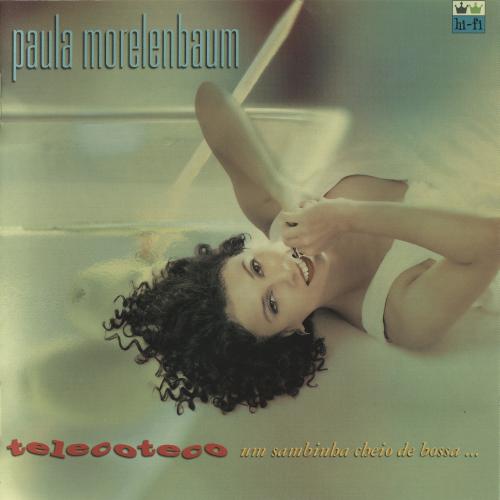
Artist: Paula Morelenbaum
Album: Telecoteco
Genre: Vocal Jazz, Bossa Nova
Label: Mirante/Universal
Released: 2008
Quality: FLAC (image+.cue)
Tracklist:
- Manha de Carnaval (Bonfa-Maria) - 4:50
- Nao Me Diga Adeus (Soberano-Paquito-Da Silva) - 3:23
- O Samba e o Tango (Regis) - 3:36
- Love Is Here to Stay (Gershwin-Gershwin) - 3:52
- Um Cantinho e Voce (De Abreu-Amorim) - 3:46
- Ilusao a Toa (Alf) - 4:02
- Teleco-teco (Caldas-Pinto) - 3:38
- Sei La se Ta (Vermelho-Silva) - 3:01
- O que Vier Eu Traco (Alvaiade-Maria) - 3:19
- Voce Nao Sabe Amar (Caymmi-Guinle-Lima) - 3:31
- Ternura Antiga (Ribamar-Duran) - 4:18
- Luar e Batucada (Jobim-Mendonca) - 3:42
DOWNLOAD FROM FILECAT.NET >>>
- Personnel:
- Paula Morelenbaum - vocals, production
- Jacques Morelenbaum - cello
- Ryuichi Sakamoto, Joao Donato - acoustic piano
- Marcos Valle - vocals, Fender Rhodes
- Leo Gandelman - saxophones, flute, arrangements, production
- Lula Galvao, Chico Pinheiro - acoustic guitar
- Antonio Pinto, Alberto Continentino - bass
- Mauricio Alves, Joao Parahyba, Sidinho - percussion
As the poet Vinicius de Moraes suggested, Bossa Nova was a mood, an atmosphere, a state of mind. But which was the path taken by Brazilian music until it gained the strength brought by Bossa Nova?
Telecoteco presents itself as somewhat of a free essay on modern pop music in Brazil. And I say so because the album seems to move by the force of a historical vision, of critical viewpoints, of concepts. Thus, its repertoire emerges like a proposal on the fundamentals of Brazilian songwriting: diversity of styles and nationalities with an openness towards influences and modernization. In essence, Telecoteco brings to the forefront the wide range, the crossover, the invention, the simplicity, the sophistication, the popular alongside the classical and the passion right next to the irony.
From its title, Telecoteco, (the word refers to the onomatopoeic sound of a particular drumming pattern) points to the samba and its playfulness, invented by a modern urban country that found in this rhythm a language capable of translating its cultural complexity. The repertoire, ranging from the late thirties to the early sixties, contains songs where the easy nature of its poeticism and musicality shine.
The other fundamental reference in Telecoteco is Bossa Nova. Most of the compositions in it preceeded this era, and announced themselves as a set of signs, heralding this musical style that would embody the whole process of modernization which popular music was undergoing at that time. The Bossa Nova feel in Telecoteco is a mood, an atmosphere. A clear example of that is the tune with the most Bossa Nova-esque flavor in the record, “Um cantinho e você”, a Samba-Canção originally recorded by Dick Farney in 1948, ten years before Bossa Nova acquired its groundbreaking format with João Gilberto’s acoustic guitar and voice.
Telecoteco, with its cleverly and extremely well researched selection of songs, lends both a powerfully intellectual and conceptual dimension, giving it a contemporary treatment where the interpretation, arrangement and instrumentation elevate the freshness and the timelessness quality of the melody, harmony and the lyric. A good example is the open, dynamic and modern treatment applied to a tune like “O samba e o tango”, a delicious mix of musical styles recorded by Carmen Miranda in 1937 on 78 rpm that incorporates Samba, Tango and Bossa Nova (the actual term “Bossa” appears in the lyrics) yet leaping straight ahead to the electronic music realm of the dance floor.
With vigor and beauty, Telecoteco intertwines Choro, Tango and American Jazz (found in Gershwin’s Latin-tinged “Our Love is Here to Stay”, showcasing the influence of the American Musical in the vocabulary of Brazilian musicians) and some of the Samba variations: the nimble and delicate, the full-tilt type and the Samba-Canção, which, until the emergence of Bossa Nova, was the modernizing factor in Popular Music songwriting.
In Paula Morelenbaum’s Telecoteco everything comes from the Samba and returns to the Samba in terms of fusion and dialogue. What is reaffirmed is exactly the fact that it is a composite of modern, old, and contemporary all capable of assimilating and treading other rhythms, languages, idioms and attitudes.

